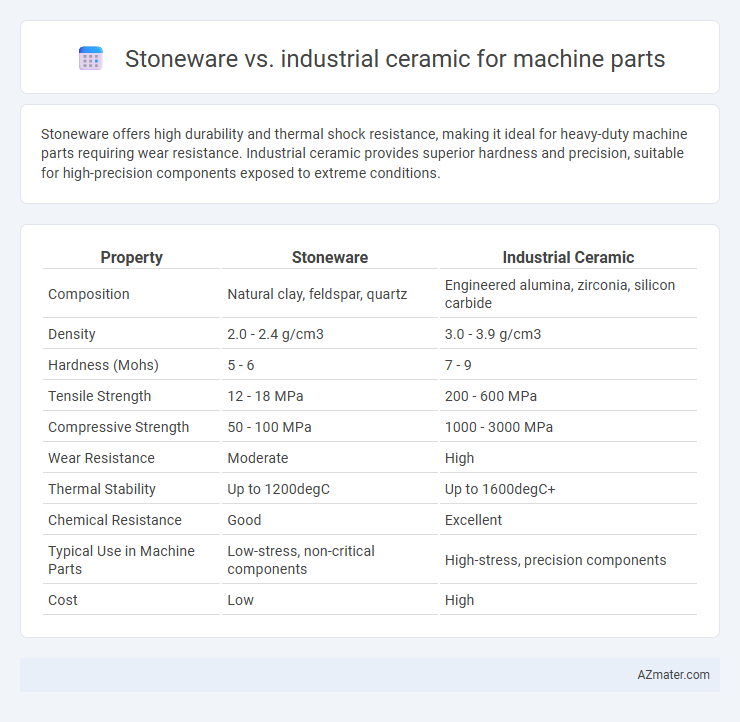Stoneware offers high durability and thermal shock resistance, making it ideal for heavy-duty machine parts requiring wear resistance. Industrial ceramic provides superior hardness and precision, suitable for high-precision components exposed to extreme conditions.
Table of Comparison
| Property | Stoneware | Industrial Ceramic |
|---|---|---|
| Composition | Natural clay, feldspar, quartz | Engineered alumina, zirconia, silicon carbide |
| Density | 2.0 - 2.4 g/cm3 | 3.0 - 3.9 g/cm3 |
| Hardness (Mohs) | 5 - 6 | 7 - 9 |
| Tensile Strength | 12 - 18 MPa | 200 - 600 MPa |
| Compressive Strength | 50 - 100 MPa | 1000 - 3000 MPa |
| Wear Resistance | Moderate | High |
| Thermal Stability | Up to 1200degC | Up to 1600degC+ |
| Chemical Resistance | Good | Excellent |
| Typical Use in Machine Parts | Low-stress, non-critical components | High-stress, precision components |
| Cost | Low | High |
Introduction to Stoneware and Industrial Ceramic
Stoneware is a dense, non-porous ceramic material known for its durability and resistance to thermal shock, making it suitable for machine parts exposed to moderate wear. Industrial ceramics, on the other hand, encompass advanced materials like alumina and silicon carbide, offering superior hardness, corrosion resistance, and high-temperature stability essential for heavy-duty machinery components. Both materials serve critical roles in manufacturing, with stoneware providing cost-effective solutions and industrial ceramics delivering enhanced performance in demanding environments.
Material Composition Overview
Stoneware for machine parts primarily consists of dense clay minerals fired at high temperatures, resulting in a strong, vitrified material with excellent wear resistance and moderate thermal stability. Industrial ceramics, often composed of alumina, zirconia, or silicon carbide, offer superior hardness, thermal resistance, and corrosion resistance due to their engineered crystalline structures and advanced sintering processes. The choice between stoneware and industrial ceramic hinges on specific performance requirements, with industrial ceramics favored for high-stress, high-temperature applications due to their enhanced material properties.
Mechanical Strength Comparison
Stoneware exhibits moderate mechanical strength with high wear resistance, making it suitable for machine parts subjected to abrasive conditions. Industrial ceramics, such as alumina and zirconia, offer superior mechanical strength, including higher fracture toughness and compressive strength, enabling better performance in high-stress and impact-prone machine applications. The enhanced mechanical properties of industrial ceramics result from advanced processing techniques and controlled microstructures, providing greater durability and reliability compared to stoneware.
Thermal Resistance Capabilities
Stoneware exhibits moderate thermal resistance with a capacity to withstand temperatures up to approximately 1200degC, making it suitable for applications requiring good heat retention and insulation in machine parts. Industrial ceramics, such as alumina and silicon carbide, offer superior thermal resistance, often exceeding 1600degC, which allows them to endure extreme thermal shocks and sustained high-temperature environments in demanding machinery. The choice between stoneware and industrial ceramic for machine parts hinges on the specific thermal resistance requirements and operating conditions of the application.
Wear and Corrosion Resistance
Stoneware exhibits high wear resistance due to its dense, vitrified structure, making it suitable for machine parts subject to abrasive conditions, while industrial ceramics offer superior corrosion resistance with chemically inert compositions ideal for harsh chemical environments. Industrial ceramics often incorporate advanced materials like alumina or silicon carbide, enhancing hardness and extending service life under mechanical stress and corrosive agents. The choice between stoneware and industrial ceramic hinges on specific operational demands, balancing abrasion resistance with resistance to chemical degradation for optimal machine part performance.
Precision and Manufacturing Tolerances
Stoneware offers moderate precision with manufacturing tolerances typically in the range of +-0.1 to +-0.3 mm, suitable for less demanding machine part applications requiring good wear resistance. Industrial ceramics deliver superior precision and tighter manufacturing tolerances often within +-0.01 to +-0.05 mm, enabling high-performance machine components with exceptional hardness, thermal stability, and resistance to corrosion. The choice between stoneware and industrial ceramics hinges on the specific dimensional accuracy and performance requirements of the machine part application.
Cost-Effectiveness Analysis
Stoneware offers a cost-effective solution for machine parts due to its lower raw material and production costs compared to industrial ceramics. Industrial ceramics, while more expensive, provide superior durability and wear resistance, reducing long-term maintenance and replacement expenses. Evaluating total lifecycle costs reveals that industrial ceramics may offer better value in high-stress applications despite their upfront cost premium.
Typical Machine Part Applications
Stoneware offers excellent wear resistance and thermal stability, making it ideal for grinding balls, seals, and insulators in heavy machinery. Industrial ceramics provide superior hardness and fracture toughness, commonly used for cutting tools, bearings, and valves in precision engineering. Both materials excel in applications requiring high durability and chemical resistance under demanding operating conditions.
Longevity and Maintenance Requirements
Stoneware offers exceptional durability and resistance to wear, making it ideal for machine parts subjected to moderate mechanical stress and corrosive environments. Industrial ceramics, such as alumina and silicon carbide, provide superior hardness, higher thermal stability, and enhanced resistance to abrasion and chemical attack, significantly extending machine part longevity under heavy-duty conditions. Maintenance requirements for stoneware are minimal due to its dense, non-porous structure, whereas industrial ceramics demand specialized handling to prevent chipping but benefit from fewer replacements and longer service intervals.
Choosing the Right Material for Your Needs
Stoneware offers excellent durability and thermal resistance, making it ideal for machine parts exposed to moderate mechanical stress and fluctuating temperatures. Industrial ceramics provide superior hardness, wear resistance, and chemical stability, suited for high-precision components in demanding operational environments. Selecting between stoneware and industrial ceramics depends on factors like load-bearing requirements, exposure to corrosive substances, and desired lifespan for optimal machine performance.

Infographic: Stoneware vs Industrial ceramic for Machine part
 azmater.com
azmater.com